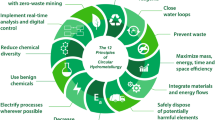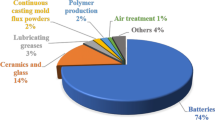Abstract
Salt in Uganda is mainly imported from neighboring countries despite the existence of a 22.5 million t of mineral deposit at Lake Katwe, Western Uganda. Earlier attempts to extract salt from the deposit did not yield the required results. To reduce on the salt import bill and improve the livelihoods of the local miners, a modified solar concentration process was designed to extract sodium chloride and other evaporites. The process flow sheets describing the constituent unit operations were modeled using SuperPro Designer. A bench-scale experiment guided by thermodynamic calculations from the PHREEQC software was conducted to validate the process flow sheets. XRD results show that halite of > 99% purity was produced after the flotation of burkeite and trona. Furthermore, soda ash and sodium sulfate were produced after the second evaporation process by a combination of flotation, carbonation, and calcination techniques. Sodium chloride is the most abundant and feasible product. The unit production cost of sodium chloride was 0.2629 and 0.4724$/kg with a net present value of $2,447,853 and − 12,085,796 of the solar salt and mechanical evaporation processes respectively. As a result, the solar salt extraction process proved highly feasible from both engineering and economic standpoints and thus can be scaled up to a pilot scale using conventional industrial equipment.












Similar content being viewed by others
References
Arad A, Morton WH (1969) Mineral springs and saline lakes of the Western Rift Valley, Uganda. Geochim Cosmochim Acta 33:1169–1181. https://doi.org/10.1016/0016-7037(69)90039-8
Barrett-Gaines K (2004) The Katwe salt industry: a niche in the Great Lakes regional economy. Afr Econ Hist 15–49. doi: http://www.jstor.org/action/showPublication?journalCode=afrieconhist
Chopra A (2020) Annual salt import grow to Shs 94.7 billion. Dly. Monit
Driver P, Tukahirwa EM (1990) Preliminary environmental impact assessment of Lake Katwe salt plant, Western Uganda
Dursun D, Koulouris A, Dalgıç AC (2020) Process simulation and techno economic analysis of astaxanthin production from agro-industrial wastes. Waste and Biomass Valorization 11:943–954. https://doi.org/10.1007/s12649-018-0439-y
Fairweather MJ, Rockandel MA, Sadan A, Swinkels GM (1986) Process for the recovery of sodium carbonate from salt mixtures 14
Garrett DE (1970) Methods for separating chloride, sulfate and carbonate salts and the like 3
Garrett DE, Kallerud MJ, Chemtob EM (1975) Beneficiation of salts crystallized for Searles Lake brine 6
Hocking MB (2005) Handbook of chemical technology and pollution control. Elsevier
Intelligen Inc (2019) SuperPro Designer, user guide. Scotch Plains, NJ, USA
Kasedde H, Bäbler MU, Kirabira JB, et al (2013) Mineral recovery from Lake Katwe brines using isothermal evaporation. In: Wolkersdorfer C, Brown A, Figueroa L (eds) Reliable mine water technology. Publication Printers, Denver, Colorado, USA, pp. 855–860
Kasedde H, Kirabira JB, Bäbler MU, Tilliander A, Jonsson S (2014) Characterization of brines and evaporites of Lake Katwe, Uganda. J African Earth Sci 91:55–65. https://doi.org/10.1016/j.jafrearsci.2013.12.004
Kasedde H, Lwanyaga JD, Kirabira JB (2015) Optimization of solar energy for salt extraction from Lake Katwe, Uganda. Glob NEST J 16:1152–1168. https://doi.org/10.30955/gnj.001367
Khan MY, Jain PK (2006) Management accounting and financial analysis for CA final paperback. Taata McGraw Hill Education, India
Kirabira JB, Kasedde H, Bäbler M, Makumbi T (2015) Phase developments during natural evaporation simulation of Lake Katwe brine based on Pitzer’s model. Br J Appl Sci Technol 11:1–7. https://doi.org/10.9734/BJAST/2015/20598
Kirabira JB, Kasedde H, Semukuuttu D (2013) Towards the improvement of salt extraction at Lake Katwe. Int J Sci Technol Res 2:76–81
Korovessis NA, Lekkas TD (2013) Solar saltworks’ wetland function. Glob NEST J 11:49–57. doi: https://doi.org/10.30955/gnj.000575
Kovacheva A, Rabadjieva D, Tepavitcharova S (2014) Simulation of stable and metastable sea-type carbonate systems for optimization of MgCO3·3H2O precipitation from waste sea brines. Desalination 348:66–73. https://doi.org/10.1016/j.desal.2014.06.012
Kyzas G, Matis K (2019) The flotation process can go green. Processes 7:138. https://doi.org/10.3390/pr7030138
Lehmann O, Nir O, Kuflik M, Lahav O (2014) Recovery of high-purity magnesium solutions from RO brines by adsorption of Mg(OH)2(s) on Fe3O4 micro-particles and magnetic solids separation. Chem Eng J 235:37–45. https://doi.org/10.1016/j.cej.2013.09.014
Lwanyaga JD, Kasedde H, Kirabira JB (2019a) Effect of temperature on mineral precipitation sequence of Lake Katwe brine during evaporation. Curr J Appl Sci Technol 33:1–12. https://doi.org/10.9734/cjast/2019/v33i630104
Lwanyaga JD, Kasedde H, Kirabira JB (2018) Thermodynamic modeling of Lake Katwe brine for industrial salt production. Int J Sci Technol Res 7:31–37
Lwanyaga JD, Kasedde H, Kirabira JB (2019b) Mineral precipitation sequence during evaporation of Lake Katwe brine. In: Wolkersdorfer C, Khayrulina E, Polyakova S, Bogush A (eds) Mine water: technological and ecological challenges. International Mine Water Association, Perm, Russia, pp. 515–521
MEMD (2016) The mining (amendment) regulations. Uganda
Morton WH (1973) Investigation of the brines and evaporite deposit of Lake Katwe, Western Uganda. Overseas Geology and Mineral Resources, No 41
Ozdemir O, Jain A, Gupta V, Wang X, Miller JD (2010) Evaluation of flotation technology for the trona industry. Miner Eng 23:1–9. https://doi.org/10.1016/j.mineng.2009.08.006
Parkhurst DL, Appelo CAJ (2013) Description of input and examples for PHREEQC version 3—a computer program for speciation, batch-reaction, one-dimensional transport, and inverse geochemical calculations. In: U.S. Geological Survey Techniques and Methods, book 6, chapter A43. p 497
Petrides D, Koulouris A, Lagonikos PT (2002) The role of process simulation in pharmaceutical process development and product commercialization. Pharm Eng 22:1–8
Razi Parjikolaei B, Errico M, Bahij El-Houri R et al (2017) Process design and economic evaluation of green extraction methods for recovery of astaxanthin from shrimp waste. Chem Eng Res Des 117:73–82. https://doi.org/10.1016/j.cherd.2016.10.015
Saydam DD, Koulouris A, Dalgıç AC (2020) Process simulation of integrated xanthan gum and sorbitol bioproduction: economic and sensitivity analysis with Taguchi approach. Process Integr Optim Sustain 4:279–295. https://doi.org/10.1007/s41660-020-00117-8
Selinawamucii.com Uganda table salt prices. https://www.selinawamucii.com/insights/prices/uganda/table-salt/. Accessed 27 Jun 2020
da Silva RG, Seckler M, Rocha SDF et al (2017) Thermodynamic modeling of phases equilibrium in aqueous systems to recover potassium chloride from natural brines. J Mater Res Technol 6:57–64. https://doi.org/10.1016/j.jmrt.2016.05.006
Svanoe H (1958) Production of Soda ash 4
UDC (1997) Lake Katwe salt production feasibility study. Kampala
Wesonga N (2013) Government spends Shs44b on salt import. Dly Monit 5
www.matche.com Matches’ process equipment cost estimates. http://www.matche.com/equipcost/Default.html. Accessed 6 Oct 2020
Acknowledgments
Special thanks go to the Hydrometallurgy Research Group at the School of Chemical and Metallurgical Engineering, University of Witwatersrand, Johannesburg, South Africa, for hosting and assisting the lead author to run the experimental work.
Funding
The authors gratefully acknowledge the financial support from the Swedish International Development Cooperation Agency (Sida) and Makerere University.
Author information
Authors and Affiliations
Corresponding author
Ethics declarations
Conflict of Interest
The authors declare that they have no conflict of interest.
Additional information
Publisher’s Note
Springer Nature remains neutral with regard to jurisdictional claims in published maps and institutional affiliations.
Rights and permissions
About this article
Cite this article
Lwanyaga, J.D., Kasedde, H., Kirabira, J.B. et al. Process Design and Economic Evaluation for the Recovery of Halite and Co-products from Lake Katwe Brine. Process Integr Optim Sustain 5, 445–460 (2021). https://doi.org/10.1007/s41660-020-00153-4
Received:
Revised:
Accepted:
Published:
Issue Date:
DOI: https://doi.org/10.1007/s41660-020-00153-4




